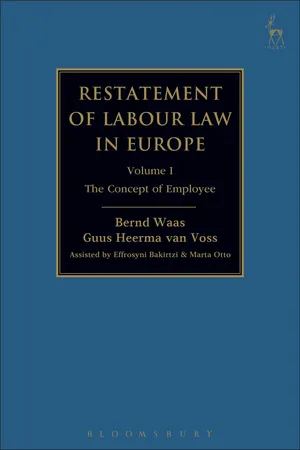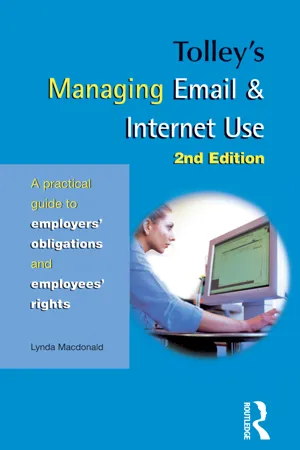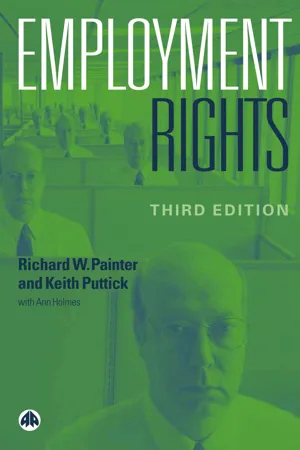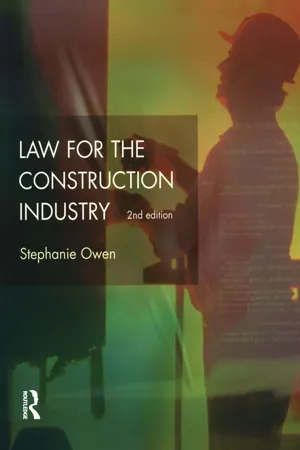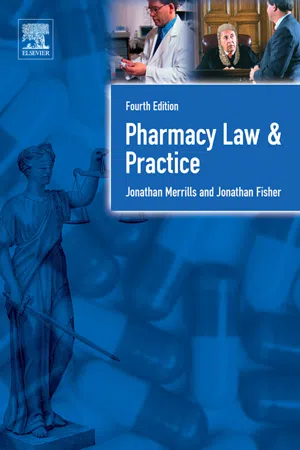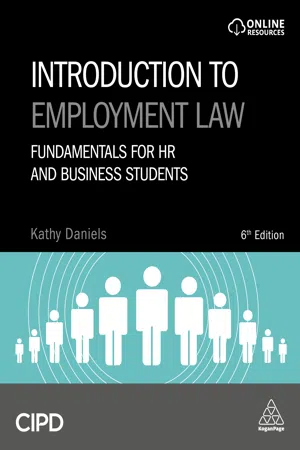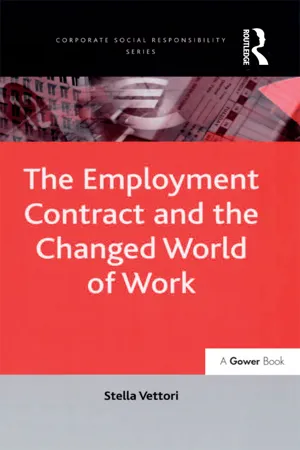Business
Contract of Employment
A contract of employment is a legally binding agreement between an employer and an employee that outlines the terms and conditions of the working relationship. It typically includes details such as job responsibilities, working hours, salary, benefits, and termination procedures. This document serves to protect the rights and obligations of both parties involved in the employment arrangement.
Written by Perlego with AI-assistance
Related key terms
1 of 5
12 Key excerpts on "Contract of Employment"
- eBook - PDF
Restatement of Labour Law in Europe
Vol I: The Concept of Employee
- Bernd Waas, Guus Heerma van Voss, Bernd Waas, Guus Heerma van Voss(Authors)
- 2017(Publication Date)
- Hart Publishing(Publisher)
In Switzerland , the law sets forth the following definition: By means of an individual Contract of Employment, the employee undertakes to work in the service of the employer for a limited or unlimited period and the * This overview was composed by Bernd Waas. xxviii Comparative Overview employer undertakes to pay him a salary based on the amount of time he works (time wage) or the tasks he performs (piece work). In the Netherlands , the law defines a Contract of Employment as a ‘contract whereby one part—the employee—undertakes to perform work in the ser-vice of the other party—the employer—for remuneration during a given period’. In some countries, statutory definitions are even more comprehensive. A case in point is Russia . According to the country’s Labour Code, an employment contract is an: [A]greement between an employer and an employee, according to which the employer obliges himself to provide the employee with work with a specific work function, to ensure the work conditions prescribed in the labour legislation as well as in other acts that contain labour law norms, collective agreements and accords, local normative acts and this agreement, to pay wages on time and in full, while the worker obliges himself to personally carry out the work function defined in this agreement in the interest and under the management and control of the employer, and to observe the internal work regulations adopted by the employer. The term ‘work function’ is used to emphasise the distinct nature of the employment relationship compared to civil law relationships and, more gen-erally, that the employment contract regulates the process of work itself rather than the outcome of work, as would be the case in civil law. Interestingly, a statutory definition also exists in the UK . This definition, however, is: [M]arked by somewhat of a paradox. - eBook - ePub
Employment Relations
Fairness and Trust in the Workplace
- Cecilie Bingham(Author)
- 2023(Publication Date)
- SAGE Publications Ltd(Publisher)
The contract defines what an employee can expect to be asked to do by the employer, and therefore influences the employee’s perceptions of what really happens, day to day, in the workplace. Each employee has a Contract of Employment that embodies an agreement between two parties: the employer who guarantees to pay wages in return for the employee agreeing to work; that is, to provide their time, effort and expertise to be deployed in ways dictated by the employer (this exchange is the essence of what is known as the ‘pay-work-bargain’ – Farnham, 1997: 3). In effect it is a contract of service stipulating the tasks to be undertaken and the remuneration that an individual can expect in return for their labour. The essential ingredients to such an agreement/contract are: an offer of work acceptance of that offer an element of consideration – something that is valuable to the employee, usually pay, by which the employer can induce the employee to be ready, willing and able to work (Wiley, 2009: 43). It is important that there is clarity about what the employee is expected to be doing and what they will receive in return. Poorly communicated terms of an employment contract can lead to misunderstandings and subsequent conflict, damaging the employment relationship and perhaps leading to perceptions of organisational injustice. As soon as an offer of employment is accepted the contract comes into play (Acas, 2013). By starting work the employee indicates that they have accepted the terms and conditions offered by the employer. If, however, any one or more of the three essential ingredients (offer, acceptance and consideration) is missing then there is no Contract of Employment. This is important, since many statutory employment rights apply only to employees with a Contract of Employment, rather than, for example, the self-employed or to someone who has a contract for rather than of service - eBook - ePub
- Lynda Macdonald(Author)
- 2009(Publication Date)
- Routledge(Publisher)
5 The Employment ContractIntroduction [5.1] A Contract of Employment forms the basis of the relationship between the employer and the employee. All the terms and conditions, rules, obligations and entitlements related to the employee’s employment will be established by reference to the contract.The law does not require a Contract of Employment to be in writing, although employers are under a statutory obligation to issue written particulars of the key terms and conditions of employment to every employee (including part–time employees) within two months of the employee starting work. These written particulars must include (amongst other things) start date, job title, rate of pay, normal hours of work, entitlement to sick pay and holidays, pension entitlements (if any), place of work and notice periods. Additionally, employers who have 20 or more employees must provide written details of any disciplinary rules that exist. Fuller details are given below in 5.19.A Contract of Employment comes into force as soon as there has been an offer of employment and an unconditional acceptance of that offer. This will be the case irrespective of whether all the specific terms of the contract have been agreed at that point in time, and irrespective of whether the offer and the acceptance were in writing or reached as a result of verbal agreement.Once the terms of a Contract of Employment are agreed, they are legally binding on both parties. This means that none of the terms of the contract can be changed without the agreement of the other party.The Inter–Relationship Between Contracts of Employment and Statutory Obligations [5.2] Employee rights that have been created by the passing of legislation are automatically incorporated into every Contract of Employment. It is not open to employers to attempt to exclude an employee’s statutory rights. Any contractual clause purporting to deny an employee such rights will be unenforceable. - eBook - PDF
- Richard W. Painter, Keith Puttick, Ann Holmes(Authors)
- 2004(Publication Date)
- Pluto Press(Publisher)
Yet in the modern context the employment relationship is still, notionally at least, founded on a bilateral, contractual relationship – with much of it focusing on contract terms agreed, and operating, at a private level. This remains so even when it is supplemented by statutory terms – as with the equality term inserted by the Equal Pay Act s. 1, or the statutory implied terms and dispute resolution and dismissal and disciplinary procedures introduced by the Employment Act 2002. In itself this does not say much about the wider role employment contracts play, or their value and interaction with other legal sources that shape employment relations. Despite their continuing importance, employment contracts are not necessarily the only repository of employment rights and responsibilities for most workers – especially given the way legislation impacts on (or even completely displaces) core areas of the employment contract, including wages, working time, and the general working environment. It is also clear, at the same time, that contracts have a much wider function in the construction and operation of the employment relationship than simply being a source of terms and conditions, or the final destination of many important collectively agreed elements that contribute to the overall bargain. Apart from providing a gateway to statutory rights – particularly when it assists ‘employee’ status – contract terms can then have a complex interaction with all the other main sources of employment law. The main one, legislation, has now, itself, been knocked off the top of the hierarchy of sources of employment rights and duties by a higher set of regulatory norms in the form of ECHR Convention rights: a subject operating predominantly in the control of judges, in the UK and the European Court of Human Rights in Strasbourg. - eBook - ePub
- J.R. Lewis, Stephanie Owen(Authors)
- 2014(Publication Date)
- Routledge(Publisher)
9 Employment lawThe Contract of EmploymentLike all other areas of contract law, the basic principles apply. Thus, without the essential elements of a contract, the contract would be void and there would be no binding rights and duties. In addition to the rules of common law, there are a wide-ranging number of Acts of Parliament which govern different aspects of employment. The law has recently been consolidated in the Employment Rights Act 1996 (the Act).For many of these statutory rights, and indeed, for much of the common law, it is important that the Contract of Employment between the employer and the employee is one of service and not for services, as only employees have protection under these Acts (see pp. 164–5). It must be remembered that whatever the parties call the relationship existing between them, in a dispute, all aspects must be examined to discover its true nature.Form of contractLike most contracts, the contract may be in any form. Thus, it may be oral, in writing, or implied from the parties' behaviour, or by reference to trade union agreements or practice within a trade or to employer's working rules or a combination of any form. Terms may also be implied by the common law or by statute.For many people, the contract will be oral. For example, if a person goes to an interview for a job, he may be offered the job at the interview. If he accepts, the contract will be oral. If he accepts by letter, it is a combination of a written and an oral agreement. If he was offered the job by letter, which he accepts by letter, then it will be in writing. He may be given a formal contract to sign and this is usually desirable where there are unusual terms. If he is not supplied with all the terms in a written contract, then the employer must supply written particulars of the terms of employment (see below).Employer's duties towards employeesThe employer's duties are a combination of both common law and statute. Any unusual duty should be an express term of the contract. The parties may make such terms as they wish, provided they comply with basic contract rules and statutory restrictions. - eBook - ePub
- Lynda Macdonald(Author)
- 2009(Publication Date)
- Routledge(Publisher)
As regards the distinction between a full-time and a part-time contract, there is no definition in statute as to what constitutes full-time employment. A full-time contract is therefore one under which the employee works the number of hours that their employer has defined as the full-time standard for the organisation. Correspondingly, a part-time employee is one who works fewer hours per week or per month than someone working the company’s standard full-time hours.It is important to consider, before examining the management of fixed-term and part-time contracts in more detail, what constitutes a Contract of Employment, different forms of contract, what a contract consists of (express and implied terms) and what terms the employer is obliged to put into writing.What is a Contract of Employment? [2.2] The existence of a Contract of Employment establishes the relationship of employer/employee between the parties. All the terms and conditions, rules, obligations and entitlements related to the employee’s employment (other than statutory rights) will be established by reference to the contract. Workers who are not employees are not engaged on a Contract of Employment, but rather a contract for services (seeCHAPTER 1at1.1).
In order for a contract to exist, four conditions must be met. These conditions are summarised below.Conditions for a Contract to Exist [2.3] Agreement Between the Parties [2.4] For a contract to exist, there must be agreement between the parties. This usually means that there must have been an offer of employment by the employer and an acceptance of that offer by the employee. The contract will come into force as soon as an unconditional job offer has been unconditionally accepted, provided that the person making the offer had the authority to enter into a binding contract on behalf of the employer.If the offer is conditional (for example conditional upon satisfactory references, the satisfactory outcome of a pre-employment medical examination or the achievement of a defined qualification), then the contract will not normally take effect until the condition is satisfied. In the event that both parties agree that performance of the contract is to commence before one of the pre-conditions has been fulfilled, and if subsequently the condition is not satisfied, this would give the employer proper grounds to terminate the contract. Where, however, an offer of employment is absolute, ie there are no pre-conditions, any withdrawal of the offer after it has been accepted but before the person has started work would constitute a breach of contract. The individual would then be able to recover damages equivalent to the period of notice to which they were entitled under the contract. - eBook - PDF
- Jon Merrills, Jonathan Fisher(Authors)
- 2006(Publication Date)
- Elsevier Science(Publisher)
Chapter 30 Employment Law The Contract of Employment A pharmacist needs to be aware of the basic principles of employment law. He may employ members of staff, perhaps a locum pharmacist, dispenser or shop assistant; or alternatively he may himself be an employee of a limited company, sole trader or partnership. A Contract of Employment is approached legally in the same way as any other commercial contract. Over the years, however, there have developed particular reg-ulations relating to the formation of such a contract, the conditions of service and termination of the contract. Much of the law in this area is contained in the Employment Rights Act 1996 (ERA), though some common law rules remain. Thus contracts of employment are subject to rigorous controls from the beginning to the end of the employment. The rules are complex, and they need to be examined in considerable detail in order for their application to be fully grasped. Statutory controls on the contents of the contract Statute law used to confine itself generally to termination of the contract of employ-ment i.e. unfair dismissal, redundancy and takeovers and to certain specific areas which cover employment as one among several areas of human activity, i.e. discrim-ination and health and safety. The position has now changed considerably. In the National Minimum Wage Act 1998 and the Working Time Regulations 1998, we have for the first time a general statutory control of the two most basic elements of the Contract of Employment: how much employees are paid and how long they can be required to work in return. In addition “family-friendly” measures have been introduced by the Employment Relations Act 1999 and the Employment Act 2002. Contract of service or contract for services? There is a fundamental difference between a contract of service (employment) and a contract for services, i.e. - No longer available |Learn more
Introduction to Employment Law
Fundamentals for HR and Business Students
- Kathy Daniels(Author)
- 2022(Publication Date)
- CIPD - Kogan Page(Publisher)
Be accompanied to a disciplinary or grievance meeting by a trade union representative or colleague Yes Yes No Be protected under data protection legislation Yes Yes Yes Receive paid time off for antenatal care Yes No No Take Statutory maternity/adoption/ paternity shared parental leave Yes No No Make a request for flexible working Yes No No Receive paid time off for trade union duties Yes No No Have legal protection if making a protected disclosure Yes Yes Possibly Receive protection from health and safety legislation Yes Yes YesExplore furtherDo you think that the courts have arrived at a satisfactory solution to the issue of deciding who is an employee? If not, what potential problems do you see with the current situation? What type of test might improve the current situation?3.2 The Contract of Employment
The Contract of Employment describes the basis of the employment relationship. It can be in writing or it can be agreed orally. It is of great importance in the event of any dispute, because the Contract of Employment explains the way in which the employer and employee have agreed to work together. The Contract of Employment is a legal document and employers should therefore take care in determining the content. The terms of the Contract of Employment can be classified as: 1) express terms; 2) implied terms.Express terms are terms that have been discussed and agreed between the employer and employee. They might not be in writing. It must be emphasised that express terms cannot diminish statutory rights. We examine statutory rights in more detail later in this chapter, but in essence they are rights expressed in law. So, for example, the National Minimum Wage (NMW) is determined by statute. Potentially, the employer can offer a wage of a lower level than the NMW and the employee can accept this. However, if the employee then challenges this wage in the court, the employer cannot argue that it is fair because it was agreed between the two parties – because it has diminished the employee’s statutory rights. - eBook - ePub
- Malcolm Sargeant, David Lewis(Authors)
- 2020(Publication Date)
- Routledge(Publisher)
Chapter 4The Contract of Employment
Chapter Contents- 4.1Express terms
- 4.2The statutory statement
- 4.3Implied terms
- 4.4Duties of the employer
- 4.5Duties of employees
- 4.6Other sources of terms
- 4.7Variations in terms
- Further reading
4.1 Express terms
In the same way that contract formation can be partly express and partly by implication,1 the terms may be both express and implied. In the interests of transparency, the Contracts of Employment Act 1963 required employers to give each employee a written statement setting out certain particulars of the employee’s terms of service. This Act, subsequently amended and now contained in the ERA 1996, preceded an EEC Directive2 on this issue and, rather unusually, the adoption of European legislation required little change in domestic law. The Directive required Member States to ensure that all employees received information ‘of the essential aspects of the contract or employment relationship’.3The express terms of a written contract will normally be conclusive in the event of a dispute. In Gascol Conversions Ltd v JW Mercer 4 the Court of Appeal held that:it is well settled that where there is a written Contract of Employment, as there was here, and the parties have reduced it to writing, it is the writing which governs their relations. It is not permissible to say they intended something different.In this case the employees had signed a written statement accepting a new Contract of Employment. By way of contrast, in Systems Floors (UK) Ltd v Daniel ,5 the EAT concluded that a statement of terms and conditions of employment, given to the employee as a result of the employer’s statutory obligations,6 was only evidence of a Contract of Employment. In this case the individuals had signed a document which, it was held, was an acknowledgement of the receipt of the statutory statement. The EAT held that this statement did not constitute a written contract between the parties. It was merely a document that stated the employer’s view of the terms. It may provide strong prima facie - Stella Vettori(Author)
- 2016(Publication Date)
- Routledge(Publisher)
6 This law need not of necessity take the form of legislation. It can just as easily be judge made law or both.A brief summary of the development of the law of contract (and more specifically contracts regulating employment relationships) demonstrates how the law of contract has been adapted and interpreted by judges and at times supplemented by legislation in line with and in reaction to the changing socio-economic milieu. What has remained constant throughout the centuries, except of course in respect of slavery, is that a contract has always been a necessary foundation for the creation of the employment relationship. At different stages in history legislation has played a major role in regulating the employment relationship. During these times the relationship has been described as a status relationship7 as opposed to a contractual relationship. Despite the fact that most terms and conditions were regulated by statute, and that the creation of the relationship was often based on a fiction of consent, given the inequality of bargaining power between the parties, contract remained the foundation of the relationship. As technology has changed the world of work over the centuries, the adaptation of the laws regulating work relationships have usually served the interests of those in a position to wield economic and social power.8What follows is an assessment of the history of the Contract of Employment in order to be in a position to properly assess its future. This will assist in the explanation for the broadened scope of the application of the general principles of contract law in order to achieve both flexibility and fairness in today’s world of work. The role of the law of contract in this regard is even more significant in common law jurisdictions such as England, the United States of America and Australia given the recent extensive influence of neo liberal theories and consequent deregulation of the employment relationship.- Louise Floyd, William Steenson, Amanda Coulthard, Daniel Williams, Anne C. Pickering(Authors)
- 2017(Publication Date)
- Cambridge University Press(Publisher)
The terms of an employment contract set out the various rights and duties of the employer and the employee. In addition to the express terms in an employment contract, there are implied terms. These are duties and obligations imposed on the employer and employee under the common law. 1 They are based on public policy or originate from the nature of the Contract of Employment (for example, between master and servant). 2 Duties implied by common law can be imposed on the employee or the employer or they can be mutual obligations. In Australia at present, there is much debate about that latter group. In the 2014 High Court of Australia decision in Commonwealth Bank of Australia v Barker (2014) 253 CLR 169 ( Barker (2014)) the court did not imply a mutual duty of trust and con fi dence into the employment relationship fl owing from the employer to the employee. As will be seen throughout this chapter, debate as to whether there is a reciprocal duty of good faith continues. Further, issues arise as to the interconnection between work, remuneration and strikes. So it is with those reciprocal duties that this discussion begins. 2.10 No work, no pay 3 – work earns remuneration That workers are entitled to earn remuneration, whether it is by way of wages or salary, for work they perform was con fi rmed by the decision in Automatic Fire Sprinklers Pty Ltd v Watson . 4 The employee ’ s duty to render services and the employer ’ s duty to pay wages may seem straightforward, in that if services are not rendered then wages may not be paid. However, there are several issues arising from this seemingly simple interdependent duty. For example, there is a question as to whether it is justi fi ed for employees to extract wages, based on the employer ’ s duty to pay wages, during lawful industrial action such as a go-slow or a work-to-rule. Chapter 5 of this book deals with industrial action and limits on payment of salary to workers who strike under the Fair Work Act 2009 (Cth).- eBook - ePub
The Changing Law of the Employment Relationship
Comparative Analyses in the European Context
- Nicola Countouris(Author)
- 2016(Publication Date)
- Routledge(Publisher)
Chapter 2 , highlight how these differences concretely affected the position of workers in relation to their ability to access statutory protection, particularly with respect to intermittent and atypical working patterns.To sum up, it could be said that a number of phenomena, such as changes in the structure of industrial production, the emergence of a more self-conscious class of industrial workers, the influence of collective bargaining, the rise of the welfare state and social legislation, contributed to the establishment of the Contract of Employment as the central organising idea both for positive law and in the theoretical discourse. By the second half of the 20th century, that ‘binary divide’62 between employees and the self-employed, to which modern labour lawyers have been accustomed, was firmly emerging in legislation and legal reasoning. To use Deakin’s words, ‘the Contract of Employment was the result of these parallel processes, in the political and economic spheres, which at this time tended towards the standardization and stabilisation of the employment relationship’.63 This chapter now returns to explore in greater detail the elements that came to shape the notion of the standardised dependent and contractual employment relationship; that is to say, the elements of personal subordination in the performance of work, continuity and full and rigid working time and bilaterality
Index pages curate the most relevant extracts from our library of academic textbooks. They’ve been created using an in-house natural language model (NLM), each adding context and meaning to key research topics.
